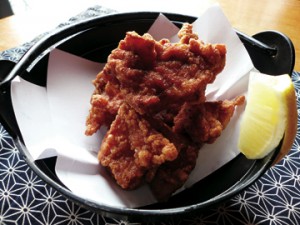Teriyaki
In food history, one of the more recent styles of Japanese cuisine, teriyaki refers to any foods – meat or fish – which are grilled in a sweet shoyu sauce marinade. In Japan, mainly fish is used – of all sorts – whilst in the West, the main dish is chicken.
Of the word, “teri” refers to the shiny glaze of the tare – the sauce marinade – due to the sugar content; “yaki”, refers to the grilling procedure. The tare sauce is traditionally made by mixing and heating shoyu sauce, sake or mirin, and sugar or honey. The sauce is boiled and reduced until it is thick, and is then used to baste the meat or fish with, prior to grilling.
Teriyaki burger
“Samurai” burger
The teriyaki burger/samurai burger was an invention of Japan’s very own fast-food establishment, MOS Burger – in 1973. Basically, hamburger buns slathered with teriyaki sauce, lettuce and a meat filling. This was due to the popularity of teriyaki-style foods, and also to MOS Burger’s penchant for creating Japanese-themed burgers. Aside from the samurai burger, the chain has also created several different rice burgers, plus the “Takumi”, or artisan burger: a 10 level burger with avocado, beef and wasabi.
Gyoza
These are dumplings which are eaten right across East Asia. Originally from China, folk tales credit their invention to the Hippocrates of the East, Zhang Ji – considered to be one of the finest physicians in Chinese history. He is believed to have lived from 150 – 219 A.D. These dumplings were, apparently, a cure for frostbitten ears. In China, they’re generally served boiled.
The fried version, which is common throughout Japan, did not appear until over 1,000 years after Zhang Ji. In Japan, the classic filling is minced pork, garlic and cabbage – as well as nira (Chinese chives). Chinese dumplings do not have the rich garlic taste, and the dough wrappers which contain the filling are thinner in Japan. They’re first pan-fried, and then shallow-boiled in water, until the upper part of the dumplings is steamed.
You’re normally served a plateful of six or so, and you dip them, one at a time, in a combined sauce of shoyu, vinegar, and a dash of chilli oil. Great with beer – or wine – and…you don’t need to have frostbitten ears to enjoy them.
Kara-age
In Japan some years ago, an English teaching colleague indulged a guilty fast food habit. When he did so, he referred to the local KFC outlet, in a contemptuous manner, as “the Dirty Bird”.†
Many may consider all fried chicken to be much of a muchness. They might respond with, ÅeHow many ways can you boil an egg?’ if we suggested that the difference between Japanese deep fried chicken and yer usual fast food fried chook is clearly that between night and day. Nevertheless, it is so. Such a simple food, and yet it is one Japanese viand that we would go back to again and again, without fail. Excellent quality chicken meat should be marinated in a mixture of soy sauce, garlic and ginger.†
Differences in this preparation can introduce subtle variations of flavour, as you will note if you compare, karaage at Soto, Kura, and Ariake. (We should note that proper American southern fried chicken must also be marinated overnight in a mix of spices and vinegar, and that the wannabe items usually served up at fast food eateries here are a travesty). As far as deep fried food goes, karaage is tempura’s less refined, but more robust cousin.
Tonkatsu
Apparently an invention of a western food restaurant in Tokyo’s Ginza district, in the 19th century. Either pork fillet or loin, cut one or two centrimetres thick, the meat is salted, peppered, dipped in a mixture of flour, beaten egg, and panko crumbs (Japanese-style breadcrumbs), before being deep fried. The meat is then sliced into bite-sized pieces, and served with shredded cabbage. (note: for really crispy cabbage, it should be sliced razor-thin and soaked in a bowl of cold water filled with ice. Drain and then serve). †A thick, Japanese-style worcester sauce, called Tonkatsu sauce, is served over the fried pork.
This is available in the Asian/Japanese food section of your local supermarket. You might try mixing in some ketchup, steak sauce, or a little mustard or lemon juice; (if the taste is a little sour, you could mix in some sugar).




